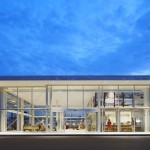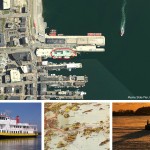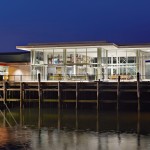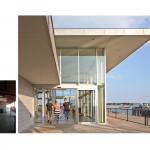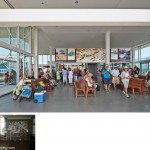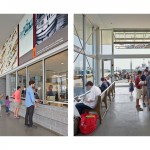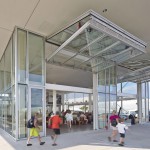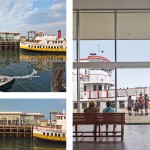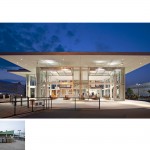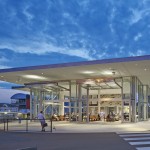Casco Bay Ferry Terminal Addition and Renovation
Project Name
Site and Program: A congested urban wharf at the entrance to Portland Harbor with competing demands for pedestrians, car queuing and freight lanes, taxis, and buses. The project included doubling the size of the indoor and outdoor waiting areas, new ticket windows, public restrooms, improved freight handling capabilities, and improvements to the marine infrastructure.
Design Challenge: Create a more connected experience for the people riding the ferries, to repair the wharf’s rotted marine infrastructure, and reconfigure the vehicular plaza on the east side of the terminal.
The original terminal was built in 1988, when the ferries were serving a smaller population. The major points of departure were Gates 1, 2, and 3, and the terminal waiting room was located in the middle of the facility, close to those gates. Today one million passengers use the ferry service, more than double the number the terminal was originally designed for. For many the ferry service is a lifeline between their year-round island homes and the mainland. As use of the terminal has increased, most people and freight are being serviced by the larger ferries at Gates 4 and 5. Passengers sitting in the former waiting room could not see their gate or boat’s arrival, so they would choose to wait outside, often in inclement weather. Because the waiting room and ticketing area were so undersized, there was frequently a long line of passengers waiting to buy tickets.
Design Solution: The new addition and reconfigured plaza have transformed the formerly dark, crowded, and inwardly looking ferry terminal into an open, joyful public space on Portland’s working waterfront. By moving the waiting room to the south end of the terminal, overlooking the harbor and Gates 4 and 5, the new addition has connected the riders directly to the beauty and allure of the island ferry experience.
The existing maintenance area and mechanical room were removed to create space for a 4,900 SF addition that would house the expanded waiting room, more efficient ticket and freight offices, and larger, more serviceable restrooms. The new waiting room is a 20-foot high light-filled space surrounded by windows with views to the harbor and the ferries. The south wall of the waiting room, facing the harbor and Gates 4 and 5, literally folds up and out of the way during the summer months, removing any barrier between the waiting room and the waterfront experience.
Due to an organic layer of material below the building site, an innovative use of geo-foam fill was required to create the site the expanded terminal sits on without adding additional loads to the sub-surface condition.
Sustainable Design Elements: Visits to the terminal are no more than 20 minutes, so the need for heating and cooling is modest. Radiant heating is located in the concrete floor slab, and cooling is provided by an economizer cycle and opening the overhead doors during the summer months. Plumbing fixtures include low-flow faucets, ultra low-flow urinals, and dual flush toilets, all with automatic sensors. Lighting fixtures are LED and the restrooms have Dyson Airblade hand dryers.
Construction Budget: $2,400,000 Addition and Renovations
$ 800,000 Marine Improvements
Funding provided by FTA, MDOT, and CBITD

